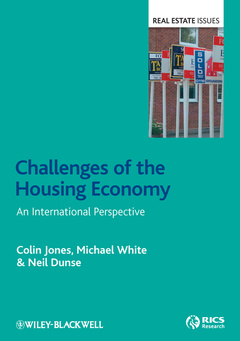Description
Challenges of the Housing Economy
An International Perspective
Real Estate Issues Series
Coordinators: Jones Colin, White Michael, Dunse Neil
Language: English
Subject for Challenges of the Housing Economy:
Keywords
timely; policy; housebuilding; book; faced; postcredit; world; industry; crunch; makers; challenges; implications; households; market; governments; choices; international; experts; examine; around; perspective brings; economy
336 p. · 18x25.4 cm · Paperback
Description
/li>Contents
/li>Biography
/li>
Challenges of the Housing Economy: an international perspective brings together experts from around the world to examine recent housing market trends. The contributions reveal common long-term trends in housing markets worldwide. Despite differences in supply conditions and the role of planning, there is a trend toward rising house prices that has created significant barriers to home ownership for young households while increasing the wealth of older generations. The financial crisis had a differential impact on housing markets but in many countries where mortgage finance became severely constrained, house prices fell and there was a dramatic fall in housing construction. The falls in house prices in these countries have ostensibly improved affordability but the housing markets have been dominated by the lowering of loan to values applicable to new mortgages which has further raised the hurdles to potential first-time purchasers.
At the same time as young households are increasingly rationed out of owner-occupation, public sector expenditure cut-backs in many countries result in limited new social housing. Instead, value for money imperatives will mean new funding models for affordable housing that require greater use of public-private partnerships. The private rented sector could potentially meet the demand for the new generation of long-term renters. However, there are doubts - in the UK at least - that this sector will be able to expand significantly or provide an appropriate type and standard of housing.
This is an essential advanced text for students and researchers of land economy and land management; property and real estate; housing policy; and urban studies.
Glossary xvii
1 Introduction: The Housing Economy and the Credit Crunch 1
Colin Jones
The Irish example 2
International historical housing market context 3
Dynamics of the housing market 6
Housing market and the economy 9
Origins and impact of credit crunch 11
Objectives and structure of the book 18
Summary 23
2 US Housing Policy in the Era of Boom and Bust 25
Harry W Richardson, Gordon F Mulligan and John L Carruthers
House prices from 1995 to present 27
Housing reforms for the future 35
Conclusion 44
3 Housing Bubbles and Foreclosures that Follow: The Case of Las Vegas 47
Craig A Depken II, Harris Hollans and Steve Swidler
Data and definition of property flipping 48
Anatomy of boom bust market dynamics 50
Foreclosure activity after the bubble burst 51
Concluding thoughts 55
4 Unemployment Risk, Homeownership and Housing Wealth: Lessons from Bubble Aftermath in Japan 58
Yoko Moriizumi and Michio Naoi
Housing bubble and burst in Japan 60
Unemployment risk and homeownership 68
Housing wealth and consumption 74
Conclusion 81
Appendices: Details of statistical analysis 83
5 The Changing Nature of Household Demand and Housing Market Trends in China 90
Edward C Y Yiu and Sherry Y S Xu
Introduction to the housing market 91
Population growth hypothesis 94
Income growth hypothesis 96
Monetary policy hypothesis 100
Conclusions 105
6 Structural Sustainability of Homeownership in Australia 108
Judith Yates
Australia’s housing system 110
Future projections of homeownership sustainability 119
Conclusions 126
7 Impacts on Wealth and Debt of Changes in the Danish Financial Framework Over a Housing Cycle 128
Jens Lunde
Dynamics of recent Danish housing market cycles 130
Changing structure of owner occupation 133
Changing mortgage finance and indebtedness 135
Financial stability of owner-occupied households 140
Conclusions 151
8 Market Stability, Housing Finance and Homeownership in Germany 153
Peter Westerheide
Characteristics of the German housing market 154
German housing price trends: an international comparison 158
Housing demand and housing investment 160
The contribution of the financing system 162
The impact of the financial crisis on the German housing market 164
High down-payment constraints and stability: contradicting aims? The role of savings behaviour 164
Conclusion and outlook 168
9 The Responsiveness of New Supply to House Prices: A Perspective from the Spanish Housing Market 170
Paloma Taltavull de La Paz
Housing supply trends 171
Spanish housing market cycle pre and post the fi nancial crisis 174
Estimation of the supply elasticity of new houses 179
Summary and conclusion 184
Appendix: Details of statistical analysis 186
10 The UK Housing Market Cycle and the Role of Planning: The Policy Challenge Following the Financial Crisis 195
Colin Jones
Housing market context 196
Anatomy of the housing market boom and bust 197
Evolution of the planning framework in the UK 205
Recent planning policies 207
The planning policy consequences of the recession and beyond 212
New planning agenda 213
Conclusions 214
11 Developments in the Role of Social Housing in Europe 216
Christine M E Whitehead
Looking back: social housing and the welfare state in Europe 217
Outcomes 226
Future developments 231
Conclusions 233
12 Delivering Affordable Housing in the UK 235
Kenneth Gibb
Historic social housing context in Scotland 238
Background to the current Scottish affordability challenge 239
Assessing the emerging models 245
Concluding discussion 252
13 The Private Rented Sector As a Source of Affordable Housing 255
Michael Ball
The private rented sector within the housing system 256
Potential policy developments 265
Potential attraction of large investors 272
Summary and conclusions 278
14 Conclusions: The Challenges Ahead 282
Colin Jones
The credit crunch 282
Commonalities and challenges 284
The future 290
Concluding remarks 292
References 294
Index 312
Neil Dunse is a Reader in Urban Studies, School of the Built Environment, Heriot-Watt University
Michael White is Professor of Real Estate Economics at Nottingham Trent University




